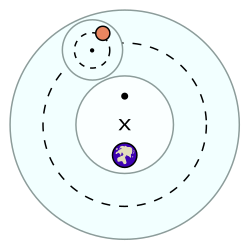Equant: Difference between revisions
m Bot: Migrating 8 interwiki links, now provided by Wikidata on d:q1965418 (Report Errors) |
SeanMcMahon (talk | contribs) No edit summary |
||
| Line 23: | Line 23: | ||
|pages=70–71}} |
|pages=70–71}} |
||
</ref><ref>[[Arthur Koestler|Koestler A.]] (1959), ''[[The Sleepwalkers]]'', Harmondsworth: Penguin Books, p. 322; see also p. 206 and refs therein. [http://www.archive.org/details/ArthurKoestler-TheSleepwalkers-AHistoryOfMansChangingVisionOfThe]</ref> |
</ref><ref>[[Arthur Koestler|Koestler A.]] (1959), ''[[The Sleepwalkers]]'', Harmondsworth: Penguin Books, p. 322; see also p. 206 and refs therein. [http://www.archive.org/details/ArthurKoestler-TheSleepwalkers-AHistoryOfMansChangingVisionOfThe]</ref> |
||
The reason Greek astronomers adopted Ptolemy's model of celestial movement was due to apparent inequalities observed in planetary motion, specifically the movement of Mars, which showed [[apparent retrograde motion]]. Mars, Jupiter, and Saturn reach the middle of their retrograde arcs when they are in opposition to the sun, while Mercury and Venus reach the middle of their retrograde arcs when they are in conjunction with the sun. Using the equant, Ptolemy can then account for the lengths of each planets retrograde arcs. |
|||
Ptolemy introduces the equant in ''Almagest''. He asserts that the epicycle's center is carried on a circle, the deferent, whose center is different from the center of uniform motion. Ptolemy never mentions how he arrived at his discovery, however the idea of the equant point was introduced during Ptolemy's explanation of longitudes and equants are later found through direct calculations. These calculations show that the center of the deferent lies halfway between the Earth and the equant point.<ref name="Equant Origin">{{cite journal|last=Evans|first=James|title=On the function and the probable origin of Ptolemy’s equant|journal=American Journal of Physics|date=1984|issue=52|page=1080}}</ref> |
|||
==References== |
==References== |
||
<references/> |
<references/> |
||
Revision as of 03:39, 13 March 2014

Equant (or punctum aequans) is a mathematical concept developed by Claudius Ptolemy in the 2nd century AD to account for the observed motion of heavenly bodies.
The equant point, indicated in the diagram by the large • , is placed so that it is directly opposite the Earth from the center of the deferent, indicated by the ×. A planet or the center of an epicycle (a smaller circle carrying the planet) was conceived to move with a uniform speed with respect to the equant. In other words, to a hypothetical observer placed at the equant point, the center of the epicycle would appear to move at a steady speed. However, the planet/center of epicycle will not move uniformly on its deferent. The angle α between the axis on which the equant and the Earth lie is a function of time t:
where Ω is the constant angular speed seen from the equant which is situated at a distance E when the radius of the deferent is R.[1]
This concept solved the problem of accounting for the anomalistic motion of the planets but was believed by some to compromise the goals of the ancient astronomer, namely uniform circular motion. Noted critics of the equant include the Persian astronomer Nasir al-Din Tusi who developed the Tusi-couple as an alternative explanation,[2] and Nicolaus Copernicus. Dislike of the equant was a major motivation for Copernicus to construct his heliocentric system.[3][4] The reason Greek astronomers adopted Ptolemy's model of celestial movement was due to apparent inequalities observed in planetary motion, specifically the movement of Mars, which showed apparent retrograde motion. Mars, Jupiter, and Saturn reach the middle of their retrograde arcs when they are in opposition to the sun, while Mercury and Venus reach the middle of their retrograde arcs when they are in conjunction with the sun. Using the equant, Ptolemy can then account for the lengths of each planets retrograde arcs.
Ptolemy introduces the equant in Almagest. He asserts that the epicycle's center is carried on a circle, the deferent, whose center is different from the center of uniform motion. Ptolemy never mentions how he arrived at his discovery, however the idea of the equant point was introduced during Ptolemy's explanation of longitudes and equants are later found through direct calculations. These calculations show that the center of the deferent lies halfway between the Earth and the equant point.[5]
References
- ^ Eccentrics, deferents, epicycles and equants (Mathpages)
- ^ Craig G. Fraser, 'The cosmos: a historical perspective', Greenwood Publishing Group, 2006 p.39
- ^ Kuhn, Thomas (1957 (copyright renewed 1985)). The Copernican Revolution. Harvard University Press. pp. 70–71. ISBN 0-674-17103-9.
{{cite book}}: Check date values in:|year=(help) - ^ Koestler A. (1959), The Sleepwalkers, Harmondsworth: Penguin Books, p. 322; see also p. 206 and refs therein. [1]
- ^ Evans, James (1984). "On the function and the probable origin of Ptolemy's equant". American Journal of Physics (52): 1080.
External links
- Ptolemaic System – at Rice University's Galileo Project
- Java simulation of the Ptolemaic System – at Paul Stoddard's Animated Virtual Planetarium, Northern Illinois University
See also
- Equidimensional: This is a synonym for equant when it is used as an adjective.

